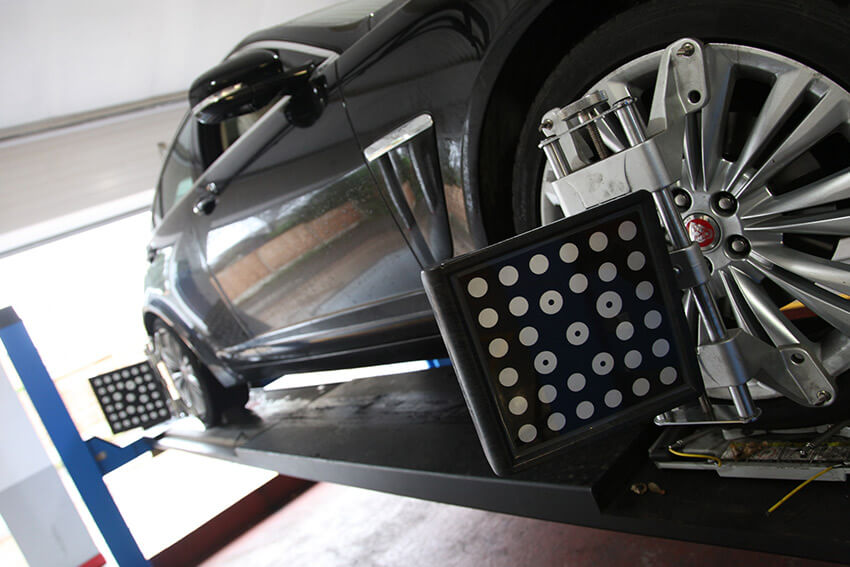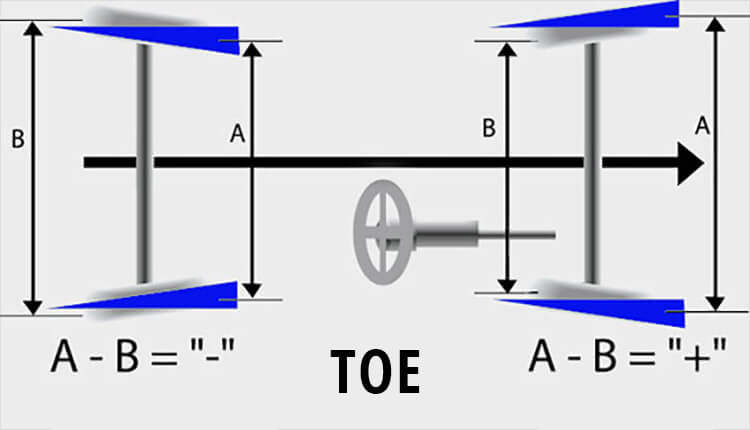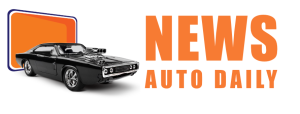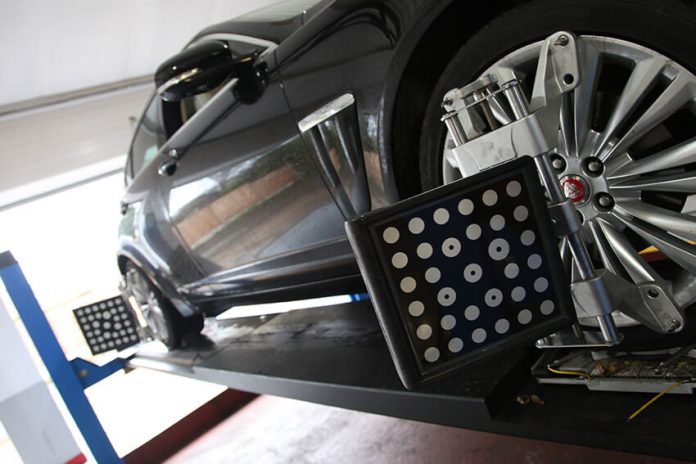
Nowadays, high-quality wheel alignment is a rarity among motorists. Service stations have become numerous, in practically every city in Russia. Of course, they all have the most modern equipment, but unfortunately, not everyone can find real, professional mechanics. Therefore, car enthusiasts, as well as professional drivers, in addition to advertising, are mainly guided by such a concept as “word of mouth”. Recommendations from acquaintances and friends.
Here’s what you need to know about wheel alignment before visiting a car service center.
All tires on your car must match your model and be of the same size. The rims on the wheels must also be identical in all parameters (width, diameter, etc.). These requirements are especially important for wheel alignment performed on a computer stand.
Wheel parameters must meet the technical requirements of your vehicle. We strongly advise against installing wheels from a classic car on a VAZ-2109 (08), or Volga wheels on a Niva, as their offset is smaller than standard. This may result in a change in the wheel’s rolling angle, which corresponds to the suspension design.
If you plan to install a new set of tires and decide to have a wheel alignment performed, be sure to correct all chassis faults and have them inspected before installing the tires. Otherwise, you may arrive at the alignment center with brand new tires, only to find a major defect that cannot be corrected on the spot and will prevent the alignment. And you will have to drive for some time on new tires without “camber”, which can be very destructive to the tires and entail additional material costs.
Here are some tips to consider before going to any auto repair shop for “camber”. To protect yourself, to be on the safe side and to avoid incompetent “specialists”:
- Before visiting the service station, equalize the pressure in your tires and check the movement of your car in a straight line, namely, fix the position of your steering wheel and count the number of turns to the right and left. The number should be equal. You must share this information with the mechanic. A good mechanic will track this anyway, but it is better to be on the safe side and be safe.
- Ask if the auto repair shop is certified for this service.
- Find out what work is included in the service and the prices for it. You can run into unscrupulous “wheel alignment specialists” who limit themselves to either camber or toe-in, but haven’t heard of caster or front and rear axle offsets.
- If possible, observe the inspection and adjustment process.
Wheel Alignment
Before starting the adjustment process, an experienced mechanic should inspect the technical condition of the vehicle, diagnose the chassis, and check the tire pressure. Any detected faults must be corrected before starting the wheel alignment, and the customer must be informed about them. Among the preparatory operations, the “wheel rim runout compensation” operation is considered particularly important and mandatory. This operation is performed to eliminate the influence of the geometric shape of the wheel rim.
Next, this is a diagnosis of the chassis geometry based on instrument readings. We detect and correct defects such as axle or side member misalignment and other faults that can affect your vehicle’s handling and stability, regardless of wheel alignment.
Which wheel alignment stand should I choose?
It’s worth noting that the stand you ultimately choose, computerized or optical (laser), is irrelevant. The key is the type of alignment technician. A good, experienced technician will perform the alignment equally well on any stand if they are a true professional, meaning they are passionate and passionate about their profession and their equipment. Their stand is always precisely calibrated, and you can confidently entrust your car to them.
The main difference between an optical and a computerized stand is measurement accuracy. The advantage of an optical stand is its simpler design and, therefore, more reliable operation. The disadvantage is that an optical stand can only diagnose one axle at a time, front or rear. If we’re adjusting the front axle, we’ll be missing an important parameter: the rear axle angle error. Rear axle steering directly affects the steering angle, stability, and handling of the vehicle. Therefore, when performing optical alignment, it’s important to consider the possibility that the steering wheel will have a slight tilt when driving straight.
A computerized wheel alignment machine is more accurate in its measurements and eliminates the drawback of a single axis, allowing it to diagnose both axles simultaneously. Since the alignment is performed on both axes simultaneously, their position relative to the vehicle’s axis of symmetry is taken into account. If the vehicle has been in an accident and the body geometry is distorted, an experienced specialist will immediately determine this. It’s worth noting that this only applies to modern computerized wheel alignment machines with a closed-loop measurement system. Older machines have an open loop and outdated software. Therefore, pay close attention to the equipment available at the service station.
A modern computerized wheel alignment machine allows you to print out the alignment results. This report will contain various parameters and definitions. Let’s clarify some basic parameters.
Camber

The angle of the wheel in the vertical plane relative to the road. If the top of the wheel is tilted toward the center of the car, the camber is negative; if it is tilted outward, the camber is positive; if there are no deviation angles, the camber is zero. The camber angles of the left and right wheels should be as equal as possible. For example, the camber of the right wheel = +36 minutes, and the left = +33 minutes. Both values are within the tolerance range. The difference between them should not exceed 30 minutes; deviation from this norm will cause the car to drift away from straight-line driving and cause one-sided tread wear. Negative camber will have a positive effect on stability when cornering, and zero camber will ensure minimal tire wear and, as a result, significantly increase the service life of the tires.
Front separate toe PARTIAL TOE
The angle between the longitudinal axis of the car and the plane that passes through the center of the left and the center of the right wheel separately.

Front total toe TOTAL TOE
This is the sum of the values of the separate toe.
Longitudinal inclination of the steering axis CASTER (King pin inclination)
CASTER is a very important parameter. It can be positive or negative. It is the angle in the longitudinal plane of the car, between the line passing through the centers of rotation of the wheel and the vertical line. The line that intersects the centers of the wheel can pass through the ball joints of the lower and upper suspension arms (Double wishbone “classic” suspension) or through the attachment points of the shock absorber strut (Such a suspension is called “McPherson”) or along the axis of the kingpin in the longitudinal plane of the car (kingpin suspension).

CASTER is calculated from the difference in the inclination values, subtracting the smaller value from the larger caster value. This parameter should not exceed 30. If the difference exceeds the permissible value, this will lead to the car being pulled towards the wheel with the smaller value.
Transverse angle of inclination of the steering axis KING-PIN
The angle of inclination of the steering axis of the wheel (kingpin) in the transverse plane when viewed from the front. Incorrect steering axis caster angle can lead to the following problems:
- Excessive road feedback;
- Excessive wear and failure of suspension components;
- Weakening of steering self-stabilization;
- Incorrect wheel alignment;
- Disturbance of straight driving on uneven surfaces.
Front and rear axle SET-BACK
This is the angle between the longitudinal perpendicular line of symmetry of the car and the line that passes through both axes of the car and connects the centers of the wheels. The closer this parameter to zero, the better. If the value is positive, it means that the left front wheel is located slightly closer to the rear wheel than the right one. If the values are negative, then the opposite is true. The same applies to the rear axle offset, but applies to vehicles with an independent rear axle.
TRUST-ANGLE
This is the amount of rotation of the rear axle in relation to the vehicle’s axis of symmetry. The closer this value is to zero, the better. If it is zero, then the axle is perpendicular to the vehicle’s axis of symmetry. If the value is positive, then the rear axle is turned to the right, negative – to the left. Although the permissible value is up to 20 minutes, you should not bring it to this value. The car will have poor control on the road and drive slightly sideways.
Malfunctions that most often appear after wheel alignment adjustment.
After adjusting the wheel alignment, the steering wheel may be uneven when driving straight. This can happen for several reasons:
- Increased free play in the steering wheel. If the camber is performed without taking this nuance into account, then when driving, the free play is selected to the right or left, which entails a slight tilt of the steering wheel.
- It happens that the steering wheel angle can change during a normal change of front wheels.
- Uneven tire pressure. Equalizing the pressure is performed before adjusting the wheel alignment, every mechanic knows this.
- There is a turn of the rear axle. The wheel alignment was performed on an optical stand, which does not take this parameter into account, or a computer stand, but with the function of measuring the angle of movement of the car turned off.
- The car has chassis defects that were not detected during the defect analysis.
If the car pulls to the side when driving straight:
- Most likely, the front tires are to blame, regardless of the fact that the rubber is new. We suggest swapping the left and right wheels. If the initial pull is in the opposite direction, then the rubber is to blame. This reason is quite common due to low-quality rubber.
- The wheel alignment was not done properly, demand that it be redone.
- When performing the wheel alignment, only the front axle was diagnosed. They forgot about the rear one.
- They did not find and did not fix the defects in the chassis.
You can get a high-quality computer wheel alignment on a modern stand from us, at the WEBER-AUTO auto service center, at reasonable prices starting from 600 rubles – diagnostics and 1200 rubles – one axle.
Call us! We always have discounts, we will always be glad to see you!
,
WEBER-AUTO Car Service
194044, St. Petersburg
Neyshlotsky Lane, Building 5, Building 3
District: Vyborgsky
Metro: Vyborgskaya – 800 m.
,
Seven days a week, from 9:00 to 21:00.
,
sto@veberauto.ru
,
8 (812) 321-00-00









